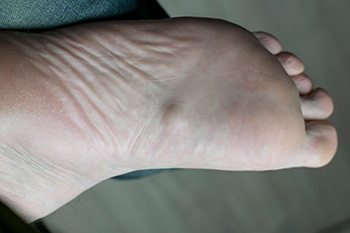(517) 487-5171
Fax (517) 908-0172
September 2024
Do Your Child's Feet Hurt?
Diagnosing Gout

Gout is a form of arthritis characterized by sudden, severe pain in the joints often beginning in the big toe. An excess of uric acid in the blood leads to the formation of sharp crystals in the joints. Symptoms include intense pain, swelling, redness, and warmth in the affected area, which can occur suddenly, often at night. The joint may also feel tender and stiff. A podiatrist will typically review your medical history and perform a physical examination to diagnose gout. Diagnosis is confirmed through tests like joint fluid analysis, where a sample of fluid from the affected joint is examined for uric acid crystals or blood tests to measure uric acid levels. If you have pain in your big toe, it is suggested that you visit a podiatrist who can diagnose and treat gout.
Gout is a foot condition that requires certain treatment and care. If you are seeking treatment, contact Dr. Gary Cesar from Michigan Foot and Ankle Center. Our doctor will treat your foot and ankle needs.
What Is Gout?
Gout is a type of arthritis caused by a buildup of uric acid in the bloodstream. It often develops in the foot, especially the big toe area, although it can manifest in other parts of the body as well. Gout can make walking and standing very painful and is especially common in diabetics and the obese.
People typically get gout because of a poor diet. Genetic predisposition is also a factor. The children of parents who have had gout frequently have a chance of developing it themselves.
Gout can easily be identified by redness and inflammation of the big toe and the surrounding areas of the foot. Other symptoms include extreme fatigue, joint pain, and running high fevers. Sometimes corticosteroid drugs can be prescribed to treat gout, but the best way to combat this disease is to get more exercise and eat a better diet.
If you have any questions please feel free to contact our offices located in Lansing and Mt. Pleasant, MI . We offer the newest diagnostic and treatment technologies for all your foot and ankle needs.
Identifying and Addressing Foot Pain

Foot problems can occur in various areas, each with distinct causes and implications. Ankle pain may arise from injuries, sprains, or conditions like arthritis, affecting mobility and stability. Pain on the inside of the foot is often linked to issues such as flat feet or posterior tibial tendon dysfunction. This is a condition where the tendon that supports the arch of the foot becomes damaged or weakened, leading to flatfoot and pain. Discomfort in the big toe, frequently associated with gout or bunions, can be debilitating and impact daily activities. Pain in the middle of the foot might indicate metatarsalgia or stress fractures, leading to discomfort during movement. Additionally, heel pain, commonly caused by plantar fasciitis or Achilles tendonitis, often worsens with the first steps in the morning. If you have any type of foot pain, it is suggested that you schedule an appointment with a podiatrist who can diagnose the cause and offer the appropriate treatment options.
Foot Pain
Foot pain can be extremely painful and debilitating. If you have a foot pain, consult with Dr. Gary Cesar from Michigan Foot and Ankle Center. Our doctor will assess your condition and provide you with quality foot and ankle treatment.
Causes
Foot pain is a very broad condition that could be caused by one or more ailments. The most common include:
- Bunions
- Hammertoes
- Plantar Fasciitis
- Bone Spurs
- Corns
- Tarsal Tunnel Syndrome
- Ingrown Toenails
- Arthritis (such as Gout, Rheumatoid, and Osteoarthritis)
- Flat Feet
- Injury (from stress fractures, broken toe, foot, ankle, Achilles tendon ruptures, and sprains)
- And more
Diagnosis
To figure out the cause of foot pain, podiatrists utilize several different methods. This can range from simple visual inspections and sensation tests to X-rays and MRI scans. Prior medical history, family medical history, and any recent physical traumatic events will all be taken into consideration for a proper diagnosis.
Treatment
Treatment depends upon the cause of the foot pain. Whether it is resting, staying off the foot, or having surgery; podiatrists have a number of treatment options available for foot pain.
If you have any questions, please feel free to contact our offices located in Lansing and Mt. Pleasant, MI . We offer the newest diagnostic and treatment technologies for all your foot care needs.
Facts About Laser Surgery for Toenail Fungus

Laser surgery for fungal toenails is an advanced treatment option designed to combat persistent fungal infections. This procedure uses targeted laser energy to penetrate the nail and destroy the fungus without harming the surrounding tissue. One notable benefit is its precision. The laser targets only the infected areas, promoting a quicker recovery. Typically, the procedure is painless and requires no downtime, allowing patients to resume normal activities almost immediately. Unlike traditional treatments, laser therapy does not involve oral medications or topical applications, reducing potential side effects. However, multiple sessions might be needed for optimal results, and some patients may experience temporary discomfort or nail discoloration. If you have toenail fungus, it is suggested that you confer with a podiatrist who can determine if laser surgery is right for you.
Laser treatment can be an effective way to get rid of toenail fungus. If you have any questions about laser treatment, consult with Dr. Gary Cesar from Michigan Foot and Ankle Center. Our doctor will assess your condition and provide you with quality treatment for fungal nails.
What Are Toenail Fungal Infections?
Onychomycosis, or fungal infection of the nail, is a relatively common and non-serious condition. Around 10 percent of U.S. citizens are afflicted with fungal nails. Common forms of fungus that infect the nail include dermatophytes, yeasts, and molds.
Symptoms of Toenail Fungal Infections Include:
- Nail thickening
- Brittleness of the nail
- Discoloration of the nail
Diagnosis for Fungal Nails
Fungal infections are diagnosed by fungal culture and microscopy. This will rule out any other conditions such as nail trauma, psoriasis, lichen planus, and onychogryphosis.
What Is Laser Treatment?
Laser treatment is a non-invasive, safe, quick, and painless procedure that uses the heat from a laser to kill fungus in the nail. Each infected nail is targeted with a laser for several minutes. The treatment is usually utilized several different times over a select period. During this time, a podiatrist will keep an eye on the infection.
If you have any questions, please feel free to contact our offices located in Lansing and Mt. Pleasant, MI . We offer the newest diagnostic and treatment technologies for all your foot care needs.
Plantar Fibromatosis

Plantar fibromatosis, also known as Ledderhose disease, is a benign condition characterized by the development of fibrous nodules along the plantar fascia, the thick band of tissue that runs along the bottom of the foot. These nodules are usually firm and can be felt under the skin, most commonly appearing on the arch of the foot. Symptoms of plantar fibromatosis include the presence of plantar fibromas, or lumps, which may cause discomfort or pain, especially while walking or standing for prolonged periods. The exact cause of plantar fibromatosis is not well understood, but it is believed to be linked to genetic factors, trauma to the foot, or other conditions. Diagnosis typically involves a physical examination and imaging tests like an ultrasound or an MRI scan to assess the nodules. Treatment options include orthotics to reduce pressure, targeted exercises, steroid injections, and in more severe cases, surgical removal of the nodules to alleviate symptoms. If you notice a lump on the bottom of your foot, it is suggested that you schedule an appointment with a podiatrist for an examination, diagnosis, and treatment.
A plantar fibroma may disrupt your daily activities. If you have any concerns, contact Dr. Gary Cesar of Michigan Foot and Ankle Center. Our doctor can provide the care you need to keep you pain-free and on your feet.
Plantar Fibroma
A plantar fibroma is a fibrous knot in the arch of the foot. It is embedded in the plantar fascia which is a band of tissue that extends from the heel to the toes along the bottom of the foot. There can be multiple plantar fibromas in the feet at the same time. There are no known causes for this condition. If you have a plantar fibroma, there will be a bump in the arch of your foot that cannot be missed. Any associated pain is most often due to a shoe rubbing against the nodule. Non-surgical options, such as steroid injections, physical therapy, and orthotics should be tried first. Surgery is a last resort and is the only thing that will remove a plantar fibroma entirely. Consult with a podiatrist for a proper diagnosis and to determine the treatment regimen that is right for you.
What Causes a Plantar Fibroma?
While there are no specific causes identified, a plantar fibroma can possibly come from genetic predisposition or the formation of scar tissue that forms from healing the tears in the plantar fascia.
What Are the Symptoms of a Plantar Fibroma?
There will be a noticeable lump in the arch of the foot that may or may not cause pain. If pain is felt, it is typically because a shoe is rubbing up against the lump or when walking or standing barefoot.
Treatment and Prevention
A plantar fibroma will not disappear without treatment, but it can get smaller and be a non-issue. If pain persists, a podiatrist examines the foot and when the arch of the foot is pressed, pain can be felt down to the toes. An MRI or biopsy might be performed to help diagnose or evaluate the plantar fibroma. The following non-surgical options are generally enough to reduce the size and pain of these nodules:
- Steroid injections
- Orthotics
- Physical therapy to help apply anti-inflammatory creams on the bump
Surgery is considered if the mass increases in size and the patient continues to feel pain after non-surgical methods are tried.
If you have any questions please feel free to contact our offices located in Lansing and Mt. Pleasant, MI . We offer the newest diagnostic tools and technology to treat your foot and ankle needs.









